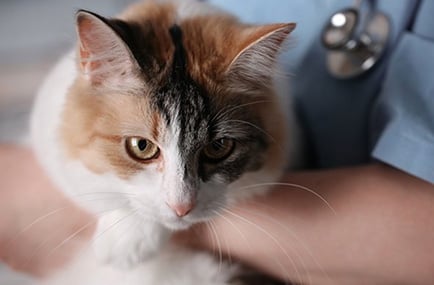Table of Contents
Key Takeaways
- Buprenorphine is used to relieve pain in cats.
- It is an opioid medication that also goes by the names Buprenex, Simbadol, and more.
- There is a low risk of side effects with buprenorphine, but the most common one is sedation.
- Buprenorphine is most commonly used as an injectable medication or as an oral (transmucosal) medication.
- Discuss buprenorphine with a vet to determine if it is right for your cat.
Your four-legged friends might not be able to complain about discomfort, but you can definitely help them. After you learn how to tell if your cat is in pain and what to give your cat for pain relief, you can learn more about specific medications like buprenorphine.
Buprenorphine is a medication used for pain relief in cats and can be very helpful, but make sure to ask your veterinarian for advice.
Just because your cat can’t yell “ow!” doesn’t mean she doesn’t feel pain.
Veterinarians have a wide variety of pain relievers to call into service if your cat’s feeling any pain especially after surgery or dental procedures or for chronic conditions, like cancer. Buprenorphine is a synthetic opiate and an effective option with relatively few side effects.
Buprenorphine Is a Narcotic
Buprenorphine may be familiar to you by its traditional brand names: Buprenex and Simbadol. Because it’s a narcotic and vulnerable to misuse and abuse, buprenorphine is controlled by the Drug Enforcement Agency and available only by a veterinary prescription for your cat. It is best used for moderate levels of pain in cats.
Buprenorphine is one of the most commonly used pain medications in cats because of its effectiveness combined with a low risk of side effects.
Side Effects
One of the reasons vets rely on buprenorphine as a pain medication for cats is because it has low risk of side effects when it’s administered properly. The most common side effect of the drug is sedation, although vomiting, constipation, difficulty urinating, abnormally low or high body temperature, altered behavior, dilated pupils, and slow breathing may also be seen.
Despite the fact that most potential side effects are relatively minor, there are cautions to using the drug. Veterinary Partner advises that cats with severe kidney disease should not use the drug, and it should be used with caution if the cat has liver disease since the liver is responsible for removing buprenorphine from the body. Other conditions that preclude its use include heart failure, head trauma, respiratory disease, or pregnancy and lactation.
Ask your vet about what method is best to administer medication to your cat.
Administering Buprenorphine
One of the other benefits of this pain reliever is its ease of administering it to your cat. Your vet may use buprenorphine as an injectable, however, if prescribed for home use, you’ll likely administer it as an oral liquid or spray. Buprenorphine shouldn’t be swallowed; it is absorbed into the body directly through your cat’s oral membranes. This is referred to as transmucosal administration. The dosage impacts how often the medication is administered; the larger the dose, the longer its effects last.
Ask your vet if buprenorphine will interact with any of your cat’s other medications.
Cautions and Contraindications
Make sure you and your vet are on the same page about what medications your cat is already taking because buprenorphine can have negative interactions with other drugs, particularly sedatives or other opioids. Buprenorphine may also alter the effects of diuretics and skeletal muscle relaxants. It should be stored at room temperature, in a cabinet or other place shielding it from light exposure.
This article is provided by Cuteness—the go-to destination for passionate pet parents. Cuteness has answers to all of your health, training, and behavior questions – as well as the cutest, funniest, and most inspiring pet stories from all over the world.








